Published in Atalanta (Markleuten)
Exact reference:
Kosterin, O. E. 2002. New records of butterflies (Lepidoptera, Diurna)
for the Tyva Republic [Tuva]. III. Hitherto not reported species and some
considerations about the Erebia magdalena Strecker, 1880 and
Polyomatus icarus (Rottemburg, 1775) groups. - Atalanta - Vol. 33 -
No. 1/2 - p. 177-187, pl. 8-9.
New records of butterflies (Lepidoptera, Diurna) for the Tyva Republic [Tuva]. III. Hitherto not reported species and some considerations about the Erebia magdalena Strecker, 1880 and Polyomatus icarus (Rottemburg, 1775) groups.
O. E. Kosterin
Abstract. Recent collections made in Tyva Republic (Tuva) yielded 11 species so far not specially recroded for this territory. Seven of them (Spialia orbifer (Hubner, [1823]), Pyrgus sibiricus Reverdin, 1911, Parnassius stubbendorffii (Mé
né
trie
s, 1849), Brenthis daphne ([Denis et Schiffermüller], [1775]), Erebia pandrose (Borkhausen, 1788), Aricia chinensis (Murray, 1974), Plebejidea cyane (Eversmann, 1837)) were quite expectable as known from the adjancent regions. Records of Erebia magdalena Strecker, 1880 erinnyn Warren, 1932, Erebia dabanensis Ershov, [1871], Oeneis melissa tunga Staudinger, 1894 are interesting as extending westwards the known range of this taxa from the East Sayan Mts; the first finding of Hyponephele narica ([Huebner], 1808-1813) in Siberia is discussed in another paper. Specimens of Thersamonolycaena dispar (Haworth, 1803) from the Ubsu-Nur Hollow are attributed to the ssp. aurata (Leech, 1807). Taxonomy of Erebia magdalena Strecker, 1880 s. l., and the status of Polyommatus icarus korshunovi Gorbunov, 1995 are discussed; the holotype and two female paratypes of the latter taxon are depicted.
Резюме. Недавние сборы в Республике Тыва (Тува) дали 11 видов, до сих пор не отмеченных для этой территории. Семь из них (Spialia orbifer (Hubner, [1823]), Pyrgus sibiricus Reverdin, 1911, Parnassius stubbendorffii (Ménétries, 1849), Brenthis daphne ([Denis et Schiffermüller], [1775]), Erebia pandrose (Borkhausen, 1788), Aricia chinensis (Murray, 1974), Plebejidea cyane (Eversmann, 1837)) были в достаточной степени ожидаемы, так как известны из прилежащих территорий. Обнаружение Erebia magdalena Strecker, 1880 erinnyn Warren, 1932, Erebia dabanensis Ershov, [1871], Oeneis melissa tunga Staudinger, 1894 интересно, так как расширяет известные ареалы этих видов к западу от Восточного Саяна; первая находка в Сибири Hyponephele narica ([Huebner], 1808-1813) обсуждается в другой статье. Экземпляры Thersamonolycaena dispar (Haworth, 1803) из Убсу-Нурской котловины отнесены к ssp. aurata (Leech, 1807). Обсуждается таксономия Erebia magdalena Strecker, 1880 s. l. и статус Polyommatus icarus korshunovi Gorbunov, 1995; у второго изображены голотип и два паратипа (самки).
The Tyva Republic is situated in the southern Central Siberia and occupies the water catchment basin of the Yenisei River sources south of the Sayans, and also the northern part of the Ubsu-Nur Intermontane Hollow (mostly situated in Mongolia). In general its territory lies between 49o45'' and 53o43'' N and 88o48'' and 99o15' E. Further in the text a traditional Russian name 'Tuva' will be used but the present official name 'Tyva' is a more precise transliteration of the self-naming of the Tuvinians.
During an expedition to Tuva in July 2000, kindly supported by Prof. T. Fujioka (Tokyo, Japan), I collected 7 species hitherto not reported for this Republic (plus one more found in 1990). One of this findings will be soon description of a new subspecies Hyponephele narica ambialtaica Kosterin, in litt., the others are reported herewith. In June 2001, Dr. I. I. Lyubechanskii, Dr. R. A. Dudko (the Institute of Systematics and Ecology of Animals of Siberian Division of Russian Academy of Sciences) and A. A. Dudko have collected three more hitherto not recorded species, although one of them was already collected in 1989 by I. V. Tishin and identified by Dr. V. K. Tuzov (pers. comm.), but this was not published. The mentioned persons kindly allowed me to publish these finding here. The materials collected also enspired to discuss the range and status of two Lycaenidae subspecies and intraspecific taxonomy of Erebia magdalena Strecker, 1880 s. l. and Polyommatus icarus (Rottemburg, 1775). The materials mentioned in this paper are preserved in the Siberian Zoological Museum at the Institute of Systematics and Ecology of Animals of the Siberian Division of the Russian Academy of Sciences, Novosibirsk (SZMN) and in the collection of Prof. Tomoo Fujioka (Tokyo).
Spialia orbifer (Hubner, [1823]).
Materials: Tyva Republic, Tes-Khem District, the Shivilig-Khem River gorge several km upstream of its leaving the East Tannu-Ola Mts., 50o47' N 94o36' E, a steppefied terrace meadow, 1.VII.1990 - 1 spec. (O. Kosterin leg.)
This Transpalaearctic species is local and never abundant, that is true for Tuva as well, since it was never reported from there and now is reported by a single specimen.
Erebia magdalena Strecker, 1880 erinnyn Warren, 1932 (= Erebia erynnis Staudinger, 1894, homonym; Erebia erinna Staudinger, 1894, homonym, = E. sajanensis Korshunov, 1972, homonym).
Materials: The border of Tyva and Khakas Republics, the Saylyg-Khem-Taiga Mt. Range; the Sayanskii Pass (of the road Abaza - Ak-Dovurak), 51o42' N 89o 52' E, 2500 m above sea level, large-stoned screes at local mountain tops, 7.VII.2000 - 1 $ 1 # (Fig. 1) (O. Kosterin leg.)
On 7th July 2000 on the Saylyg-Khem-Taiga Mt. Range (representing the central axis of the West Sayan Mts.) dividing the Tyva and Khakas Republic, I collected a male and female belonging to the Erebia magdalena Strecker, 1880 group, hitherto unknown for the West Sayan. They were found on large-stoned screes at local mountain tops. Geographically the closest representative of this group is the so-called Erebia erinnyn Warren, 1932, considered as ranging in the East Sayan (the Tunkinskie Gol'tsy and Munku-Sardyk Mts., the latters being the type locality) (Korshunov, Gorbunov, 1995) and the Baikal area (Tuzov et al., 1997). Recently its subspecies E. erinnyn chara Churkin, 1999 has been described from the Kodar Mts (N Transbaikalia) (Churkin, 1999). A close taxon E. magdalena sachaensis Dubatolov, 1992 (=ola Korshunov, 1995, mentioned also as a subspecies of Erebia mackinleyensis Gunder, 1932 sensu Korshunov et P. Gorbunov, 1995 and Erebia semo Grum-Grshimailo, 1899 sensu Korshunov, 1996 et 2000) ranges from Yakutia and the mountains of Bureya to Magadan Province and Chukotka (Korshunov, Gorbunov, 1995; Tuzov et al, 1997; Gorbunov, 2001). The nominotypical E. magdalena Strecker, 1880 has been described from Colorado, another subspecies mackinleyensis Gunder, 1932 is present in Alaska and the Rocky mountains (Scott, 1986). The main features thought to distinguish E. erinnyn from E. magdalena sachaensis are is the presumed absence of real (paleomorphic or neomorphic sensu Warren, 1932) tufted androconial scales on the male wings (while E. magdalena sachaensis have quite variable palaeomorphic scales, shown in (Korshunov, 1996)) and, in the male genitalia, a wider tegumen, a shorter valva with a more or less expressed neck and a more blunt and inwards curved apices, so that valva sometimes looks somewhat truncated in lateral view, and a less sclerotized distal part of the aedeagus (Lukhtanov, Lukhtanov, 1994; Korshunov, Gorbunov, 1995; Churkin, 1999).
However, Pavel Gorbunov, who examined my West Sayanian male specimen, has found palaeomorphic scales, although extremely rare, among abundant eomorphic (elongate but without a tuft) scales and hairs, just below the lower cell vein of on the wings of the male as well (Gorbunov, 2001). Iprepared and examined myself eight (!) slides from the same wing area and found one palaeomorphic scale (Fig. 2). Additional fresh material from the West Sayan would be most welcome to study the real frequency and the range of shapes of the androconial scales in tuhe local population.
We should take into account that the butterflies of this group could have reached the West Sayan (presently the west extremety of the group's range) only through the East Sayan, that is the type locality of erinnyn. This would allow to suggest that the androconial scales can be present in the East-Sayanian erinnyn as well, at least in some specimens. Consequently, the difference between erinnyn and magdalena may refer just to abundance of real androconial scales. Indeed, the androconial scales are obviously a plesiomorphic character for all butterflies, and cannot be considered as apomorphic for different Erebia species, as Warren (1932) thought. This means that their absence or scarsity can result only from turning off the genetic programme transforming normal scales into androconial one. In the taxon erinnyn, this programme does work, although incompletely expressed, to produce numerous eomorphic scales, being the first steps of transformation of scales to the androconial ones. Our finding may indicate that in some scales this program can be expressed completely.
P. Gorbunov (2001) considers that the differences in genitalia between erinnyn and magdalena is insufficient for species separation, since the valva shape is very variable within the group, and are on a level of good subspecies. The differences in androconial scales may also, as we have seen, be of a quantitative nature. Therefore, following Tuzov et al. (1997) and P. Gorbunov (2001), I refer to the taxon erinnyn as a Sayanian subspecies of Erebia magdalena and attribute my specimens to it.
The lighter chestnut central area is expressed on both sides of the fore wing in the female and only on the underside in the male; on the hind wing underside of the female the traces of the reduced medial band can be noticed (Fig. 1). Hence, the lighter areas are much less expressed than in the specimens from Mondy, the East Sayan, described and draught in (Korshunov, 1996), with a lighter area well expressed on both wing sides in males and also on the hind wing upperside in females, but are almost identical to the specimens from the same very place depicted in (Tuzov et al, 1997). The genitalia of the West Sayanian male (Fig. 3) resemble those of the lectotype of E. erinnyn (Lukhtanov, Lukhtanov, 1994) but the valva apex, in lateral view, is somewhat more stretched out, as if a bit shifted to the shape common in E. magdalena sachaensis.
Erebia dabanensis Ershov, [1871].
Materials: Tyva Republic, Kyzyl District, the Dongul-Taiga mountain range, mountain tundra, 17.VI.2001 - 1 $ (R. A. Dudko leg.); the same range, highlands, 18.VI.2001 - 1 $ 1 # (I. I. Lyubechanskii & R. A. Dudko leg.); the same range, alpine meadow, 22.VI.2001 - 1 # (I. I. Lyubechanskii leg.); Tyva Republic, Kyzyl District, the Khertesh-Taiga Mt. Range, 2000-2500 m above sea level, 20.VI.2001 - 3 $ (I. I. Lyubechanskii leg.).
As in the previous species, the hitherto known westernmost locality of this one was the East Sayan. Now it was collected by Drs. I. Lyubechanskii and R. Dudko on the Dongul-Taiga and Khertesh-Taiga mountain ranges being the western spurs of the Academician Obruchev Upland (or Range), the latter representing its main axis. The two ranges face the Ulug-Khem (Large Yenisei) River and form the left board of its quite a steep gorge. 300 km easterly, on its opposite end, the Obruchev Upland is joint to the East Sayan, so this finding is not too surprising. Yet this is the first report of this species for the Republic.
Oeneis melissa (Fabricius, 1775) tunga Staudinger, 1894.
Materials: Tyva Republic, Kyzyl District, the Dongul-Taiga mountain range, mountain tundra, 17/VI.2001 - 1 $ (R. A. Dudko leg.); the same range, highlands, 18.VI.2001 - 1 $ 1 # (I. I. Lyubechanskii & R. A. Dudko leg.); the same range, alpine meadow, 22.VI.2001 - 1 $ (I. Lyubechanskii leg.)
The taxon tunga was described from the East Sayan, that was thought to be the westernmost part of the entire species range. In 1989 it was collected in the Todzha Hollow in NE Tuva by I. V. Tishin and determined by Dr. V. K. Tuzov (pers. comm.) but this finding was not published. This new record of Oe. melissa is simultaneous and fully analogous to the above considered finding of Erebia dabanensis and represent the presently known westernmost locality of this species.
Brenthis daphne ([Denis et Schiffermüller], [1775])
Materials: Tyva Republic, city park of Kyzyl: 51o43' N 94o27' E, alt. 650 m, open riparian poplar forest, 9.VII.2000 - 4$; 18.VII.2000 - visually; 29.VII.2000 - visually; 30.VII.2000 - 1$ (O. Kosterin leg.)
This species is widespread throughout the Palaearctic (mostly in the semiarid zone) and its presence in Tuva was expected with certainty, while absence from the checklists was rather accidental. The species was observed as numerous and collected in the city park of Kyzyl, being the left bank floodland of the Kaa-Khen (Lesser Yenisei) River covered with poplar (Populus laurifolia Ledeb.) parkland.
Thersamonolycaena dispar (Haworth, 1803) aurata (Leech, 1807) (= parva (Kurenzov, 1941); = dahurica (Graeser, 1888))
Materials: Tyva Republic, Erzin District, sedge lake bank on the Tes-Khem right bank floodland 5 km SW of v. Erzin, 50o15' N 95o06' E, 13.VII.2000 - 1 $ (O. Kosterin. leg); Tyva Republic, Erzin District, a dry sandy steppe with Caragana bungei NW bank of Lake Tere-Khol', 50o03' N 95o00' E, 15.VII.2000 - 2$ 2# (Fig. 4) (O. Kosterin, N. Priidak leg.)
These butterflies collected in Erzin District undoubtedly belong to the subspecies aurata. They demonstrate the diagnostic features of this subspecies (Korshunov, Gorbunov, 1995): a coffee-gray, without a blue tint, hind wing underside with well expressed black suibmarginal spots, and, in males, absence of the black discal spot on the fore wing upperside (Fig. 4). Earlier this subspecies was thought to range in Transbaikalia and easterly (Korshunov, Gorbunov, 1995). Most probably, it inhabits also Mongolia. Tuzov et al. (1999) listed two eastern subspecies: "ssp. dahurica (Graeser, 1888) - Transbaikalia" and "W. Amur region; and ssp. aurata (Leech, 1887) (= borodowskyi (Grum-Grshimailo, 1900); = parvus (Kurentzov, 1941) - Central Siberia, E. Amur and Ussuri regions". Unfortunately, they did not report characters by which they distinguished these two subspecies, that would be very important in case of such a strange distribution (the range of dahurica situating within the range of aurata).
Aricia chinensis (Murray, 1974)
Materials: Tuva Republic, at city Kyzyl, dry stony steppe on the southern slope of the mountains on the Ulug-Khem River right bank, 51o43-44' N 94o26' E, alt. 650-1000 m, 17.VII.2000 - 1$ (O. Kosterin leg.)
This species is known from the regions situated just to the north (Lake Shira in Khakasia, the Tagar island at Minusinsk in the Krasnoyarskii Krai Province) and to the south (Mongolia) of Tuva: (Korshunov, Gorbunov, 1995) but somehow was not hitherto found from Tuva itself. Now we are filling this gap.
Plebejidea cyane (Eversmann, 1837)
Materials: Tyva Republic, Kyzyl District, the Malyi Shivilig River valley - 1# (I. I. Lyubechanskii leg.)
Again, a species quite expected but for some reason not yet reported for Tuva. It is monophagous and so strictly connected with Goniolimon speciosum (Plumbaginaceae), which is quite common in Tuva. Now a female was collected in the Malyi Shivilig River valley which descends from the Dongul-Taiga range southern slope and falls into the Bii-Khem (Large Yenisei) River.
Polyomatus icarus (Rottemburg, 1775) korshunovi P. Gorbunov, 1995
This subspecies was described by P. Gorbunov in (Korshunov, Gorbunov, 1995) in Russian; below is an English translation (references to figures are introduced here):
"In the populations of S Siberia the appearance of butterflies is very diverse. However, in arid regions on average smaller individuals, with somewhat narrower wings, a whitish wing underside ground colour in males and grayish in females, evidently predominate. The orange submarginal spots in them are smaller than in the butterflies from more northern regions and are isolated from each other. The females have or have not red small submarginal lunules on the wing upperside, which is often substantially suffused with blue scales. Based on these characters we state a subspecies Polyommatus icarus korshunovi P. Gorbunov, sbsp.n.
Materials: The holotype: a male (Fig. 5 a; Fig. 6 a) - 26.05.1990, Tuva, the Erzin River valley (V.V. Dubatolov). Paratypes: a male - the same locality; 2 females - 27.07.1972, Tuva, Toora-Khem (Yu.P. Korshunov); a female - 19.08.1962, Tuva, the Tes[-Khem] River (L. Violovich); a fenale and male - 17.06.1963, the same locality; 2 males - 18.06, 1987, Tuva, the Toszha District, Lake Azas, (V. Zinchenko); a male - 1-5.05.1993, Tuva, the Kyzyl city environs (D. Logunov); 2 males - Tuva, the Shivilig-Khem River, a bushy steppe (O. Kosterin); 3 males - 21.06.1907, SE Altai, the Chuiskaya Steppe, Kosh-Agach; a female - 13.07.1097, the Chuiskii Tract road, the Kuraiskaya Steppe [a collector is dropped - it was E.G. Rodd]; a female - 19.07.1966, SE Altai, between the mountain Supor and the Chuiskaya Steppe, 2000-2400 m [above the sea level]."
First of all, noted should be that inclusion of the specimens from the Todzha Hollow (namely, 2 females from Toora-Khem and 2 males from Lake Azas) into the type series was misleading. Most probably, this was done automatically by preposition that all the Tuvinian populations are homogenous. In fact, the Todzha Hollow differs drastically from the rest Tuva, this is rather a humid woody area resembling the West Sayan and Baikal regions by its natural conditions. I examined the type series and visited Todzha on 20-27th July 2000 where collected P. icarus just at Toora-Khem and Azas. The specimens from Todzha, including the paratypes of korshunovi, are very different from those of arid Central and Southern Tuva: their wing underside ground colour is grayish in males and brownish-gray in females, the submarginal spots are large and contact each other but in males often very bleached, yellowish and almost lacking the colour. The females show no blue suffusion above.
In our paper (Ivonin, Kosterin, 2000) we have attributed to ssp. korshunovi the butterflies from the highlands of the Yuzhno-Chuiskii Mt. Range in SE Altai (plate XIII 9, 10). There all the females were deep violet-blue from above, but their red submarginal spots on the wing underside are quite large and contacting each other, as in the common Siberian ssp. fuchsi (Sheljuzhko, 1928). Therefore, these butterflies cannot be considering as exemplifyng ssp. korshunovi and perhaps represent a transition to fuchsi, being closer to the latter.
Specimens of P. icarus from Central Tuvinian and Ubsu-Nor Hollows are very peculiar and fit well to the above translated description, being indeed quite different from those of more humid areas of Siberia, mostly by a light underside background and small and isolate but very bright and distinct submarginal orange spots in males. The same trend seen in females in which, however, the ground colour is darker and the orange spots often contact to each other. Moreover, in our specimens collected in July the subspecific characters are even better expressed than in the holotype and those paratypes which were collected in May (Fig. 5 d-f; Fig. 6 d-f). One female collected at Erzin (Fig. 5 e; Fig. 6 e) has a bright-blue wing upperside, on both wings with a diffuse dark areas along the costa and dark submarginal spots accompanied inside with diffuse dark shevrones without spots.
Hence, the name korshunovi should be attributed to an indeed clear-cut subspecies of arid regions of Central and southern Tyva and the adjacent regons of Mongloia. Recently Tuzov et al. (1999) referred to korshunovi as a synonym to the taxon szabokyi Bálint, 1990, described fom the southern Mongolia as a species, which, in turn, was considered as a subspecies of Polyommatus (icarus) kashgarensis Moore, 1878, earlier known as Polyommatus persica Bienert, [1869], nom. praeocc. We had an opportunity to examine the two paratypes, a male and female, of P. szabokyi preserved in Siberian Zoological Museum, with the labels "MONGOLIA, Jh - Bogd., Orog-Nuur, 1988 - VIII, 3, leg. Szaboky Cs.". These butterflies exhibit an extreme expression of the same trend of reduction of the submarginal spots and lightening of the wing underside ground colour. The type series of korshunovi (excluding the Todzha specimens) are about intermediates between the 'true ' P. icarus (ssp. fuchsi) and szabokyi. This fact indicates that most probably there exists a cline of character change among conspecific forms from rather humid ranges of Siberia through Central and South Tyva to the most arid Central Asia. Hence, we would not synonymize korshunovi and szabokyi and doubt in species independence of Polyommatus kashgarensis from P. icarus. According to observations of V. V. Dubatolov in the Kopet-Dagh Mts. (pers. Comm.), the second (summer) brood has very well expressed diagnostic characters of kashgharensis while the first (spring) brood is much closer to the typical icarus. This indicated that the mentioned characters are most probably environmentally determined. If so, the charcters considered may have no taxonomic value, but for synonymization serious studies are required.
Besides, there are a number of highland species observed on 7th July on the Sayanskii Pass (see the label of E. magdalena), that is on the very border of Tyva Republic, which were not mentioned for Tuva in the literature. We think that most of them should be observed in this place by Y. P. Korshunov but he for some reason did not include them into the Tuvinian fauna in his two special publications about it (Korshunov, 1973, 1979). It is clear that these species do belong to this fauna as inhabiting highlands at least along the northern border of Tuva and should be added to the checklist of this Republic. These species are as follows: Pyrgus sibiricus (Reverdin, 1911) (common), Parnassius stubbendorffii (Mé
né
trie
s, 1849) (common), Boloria napaea altaica Groum Grshimailo, 1893 (a singe male; this taxon was hidden in (Korshunov, 1973, 1979) under the name Boloria pales), Erebia pandrose (Borkhausen, 1788) (numerous).
Acknowledgements
The author indebted to Dr. Vladimir V. Dubatolov, the curator of the lepidopterological collection os the Siberian Zoological Museum at the Institute of Systematics and Ecology of Animals (Novosibirsk) for a great help in the work and valuable comments, to Pavel Y. Gorbunov (Ekaterinburg) for fruitful discussion and permission to use his drawing of the genitalia E. magdalena; to Dr. Vasilii K. Tuzov (Moscow) for kindly providing us with the list of species collected in Tuva in 1989 by theexpedition of the Moscow Specialized Forest Management Enterprise, to Dr. Ilya I. Lyubechanskii (Novosibirsk) who kindly allowed to mention the materials collected by their expedition of June 2001. I am very grateful to Andriyan D. Doduk, the Director of the Ubsunurskaya Kotlovina State Nature Reserve for his hospitality, a permission to work on the territory of the Reserve and a great help in the course of this work, to Dr. Dmitrii N. Shaulo for promotion of the collaboration with the Reserve and his unvaluable help during the expedition to Tyva Republic, to Vladimir. I. Andreenkov, Oleg Andreenkov and Olga Andreenkiova for making possible a superb expedition to Khakasia up to the Sayanskii Pass, and to my satellite Natalya Priidak for permanent help in the field. A special gratitude is expresed to Prof. Dr. Tomoo Fujioka (Tokyo) for a financial support of the trip.
References
Churkin, S. 1999. New taxa of butterflies from Transbaikalia, Russia (Rhopalocera: Satyridae, Nymphalidae). Atalanta 29 (1/4): 107-124.
Gorbunov, P. Y. 2001. Butterflies of Russia: classification, keys for identification, genitalia. - Thesis, Ekaterinburg - 320 p.
Korshunov, Y. P. 1973. Bulavousye Cheshuekrylye Tuvy [Rohpalocera of Tuva]. - In: Fauna Sibiri [Fauna fo Siberia], issue II - Nauka, Siberian Division - Novosibisrk - p. 204-220. (in Russian)
Korshunov, Y. P. 1979. On the butterflies of Tuva // Acta et commentiationes universitatis tartuensis - T. 483: Materialy po nekotorym gruppam cheshuekrylykh SSSR. Trudy po soologii XII [Materials of Some Groups of Lepidopterans of the USSR. Proceedings in Zoology XII] - P. 3-14 (in Russian)
Korshunov, Y. P. 1996. Dopolneniya i ispravleniya k knige «Dnevnye Babochki Aziatskoi Chasti Rossii» [Additions and corrections to the book 'Butterflies of the Asian Part of Russia'] - Eta GRP - Novosibirsk - 66 p. (in Russian)
Korshunov, Y. P. 2000. Butterflies of Ural, Siberia and Far East (keys and details). - OOO 'Vitel' - Novosibisrk - 216 p.
Korshunov, Y. P., P. Y. Gorbunov. 1995. Dnevnye Babochki Aziatskoi Chasti Rossii. Spravochnik. [Butterflies of the Asian Part of Russia. A Handbook] - Ekaterinburg University Press - Ekaterinburg - 202 p. (in Russian)
Ivonin, V. V., Kosterin, O. E. 2000. A new subspecies of Polyommatus icadius (Groum-Grshimailo, 1890) (Lepidoptera, Lycaenidae) from the Russian Altai. - Atalanta - Vol. 31 - P. 171-177
Lukhtanov, V. A., A. G. Lukhtanov. 1994. Die Tagfalter Nordwestasiens. - Herbipoliana, 3. - Marklleuten - 440 s.
Scott, J. S. 1986. The Butterflies of North America. A Natural History and Field Guide. - Stanford University Press - Stanford - 583 p.
Tuzov, V. K., P. V. Bogdanov, A. L. Devyatkin, L. I. Kaabak, V. A. Korolev, V. S. Murzin, G. D. Samodurov, E. A. Tarasov. 1997. Guide to the Butterflies of Russia and Adjacent Territories (Lepidoptera, Rhopalocera). Vol. 1. Hesperiidae, Papilionidae, Pieridae, Satyridae. -Pensoft, Series Faunistica No 7 - Sofia, Moscow - 480 p.
Tuzov, V. K., Bogdanov, P. V., Churkin, P. V., Dvyatkin, S. V., Danchenko, A. L., Murzin, V. S., Samodurov, G. D., Zhdanko, A. B. 1999. Guide to the Butterflies of Russia and Adjacent Territories (Lepidoptera, Rhopalocea). Vol. 2: Libytheidae, Danaidae, Nymphalidae, Riodinidae, and Lycaenidae. - Pensoft Series Faunistica No 8 - Sofia, Moscow: - 581 p.
Warren, B. C. S. 1936. Monograph of the genus Erebia. British Museum (Natural History), London, 407 p., 104 plates.
O. E. Kosterin
Institute of Cytology & Genetics SD RAS
Acad. Lavrentiev ave. 10
Novosibirsk 630090
Russia
kosterin@bionet.nsc.ru
Figure legends.
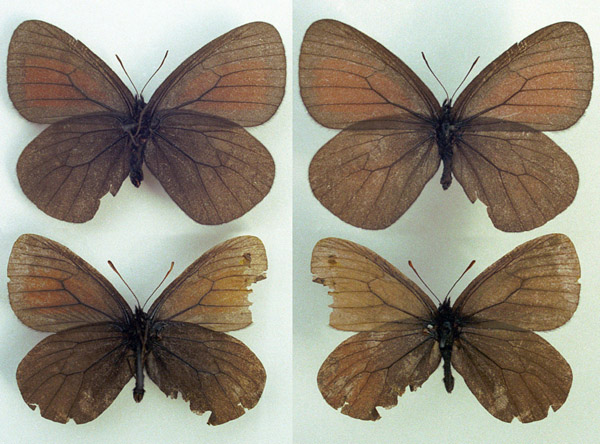
Fig. 1. Erebia magdalena Strecker, 1880 erinnyn Warren, 1932. The Saylyg-Khem-Taiga Mt. Range; the Sayanskii Pass, 7.VII.2000: female (above) and male (below), upperside (left) and underside (right).
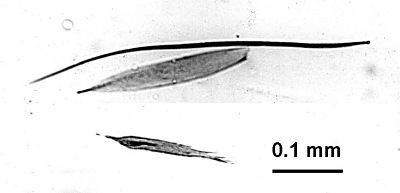
Fig. 2. A hair (above), an eomorphic androconial scale (in the middle), and a palaeomorphic androconial scale (below) found on the fore wings of the male of Erebia magdalena Strecker, 1880 erinnyn Warren, 1932 collected on the Saylyg-Khem-Taiga Mt. Range; the Sayanskii Pass, 7.VII.2000. A regular scale not shown.
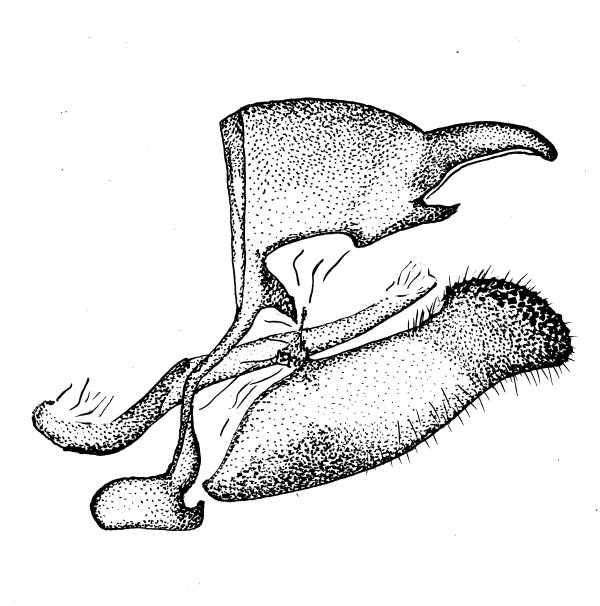
Fig. 3. The genitalia structures of the male of Erebia magdalena Strecker, 1880 erinnyn Warren, 1932 collected on the Saylyg-Khem-Taiga Mt. Range; the Sayanskii Pass, 7.VII.2000, courtecy by Pavel Y. Gorbunov.
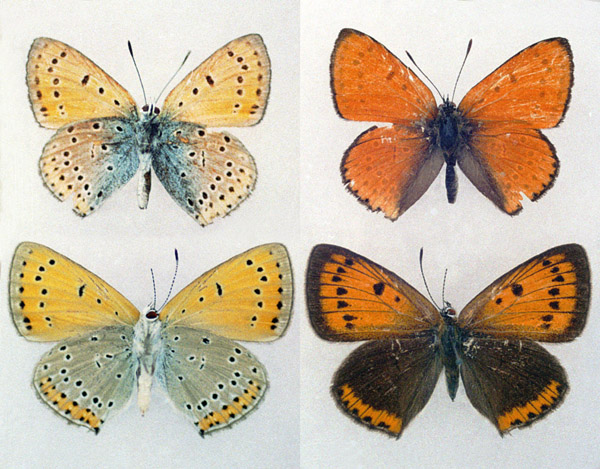
Fig. 4. Thersamonolycaena dispar (Haworth, 1803) aurata (Leech, 1807). NW bank of Lake Tere-Khol' 15.VII.2000: male (above) and female (below), underside (left) and upperside (right).
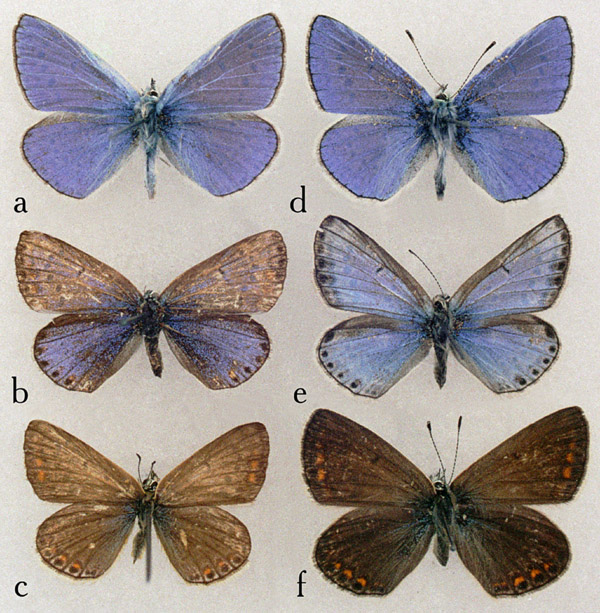
Fig. 5. Polyomatus icarus (Rottemburg, 1775) korshunovi P. Gorbunov, 1995; upperside. a, holotype, a male: [S Tuva / Erzin / river Erzin flood-plain / V.V.Dubatolov / 26.V.1990]; b, paratype, a female: Tuva, Ubsu-Nur hollow, river Tes-Khem flood-plain, 30 km downstream of village Erzin, 17.VI.1963 (N.A.Violovitsh leg.); c, paratype, a female: Tuva, Ubsu-Nur hollow, river Tes-Khem flood-plain, 30 km downstream of Erzin, 19.VI.1963 (N.A.Violovitsh leg.); d, male: Tuva, Ubsu-Nur hollow, village Erzin vicinity, left side of the Erzin River floodland, 12.VII.2000 (O. Kosterin, N.Priidak leg.); e, female: Tuva, Ubsu-Nur hollow, village Erzin vicinity, the river Erzin River left side floodland, 16.VII.2000 (N.Priidak leg.): f, female: C Tuva, Kaa-Khem District, right side of the Kaa-Khem River floodland, 15 km E of village Kaa-Khem, 30 km E of Kyzyl, 29.VII.2000 (O.E.Kosterin, N.Priidak leg).
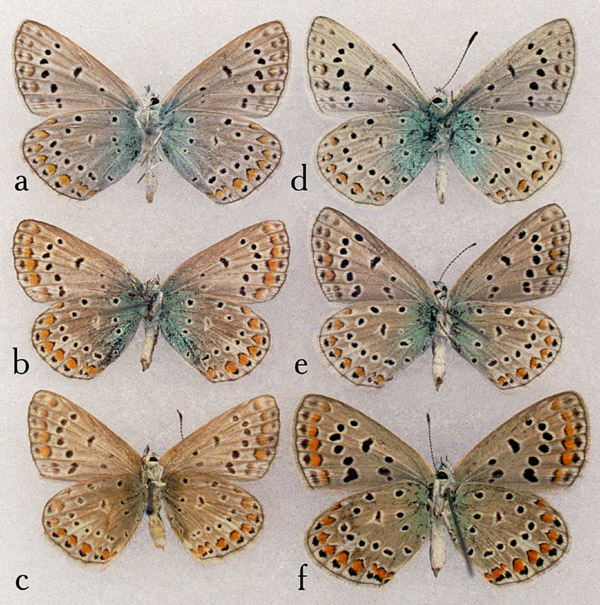
Fig. 6. Polyomatus icarus (Rottemburg, 1775) korshunovi P. Gorbunov, 1995; underside. Designation the same as in Fig. 5. a, holotype, a male: [S Tuva / Erzin / river Erzin flood-plain / V.V.Dubatolov / 26.V.1990]; b, paratype, a female: Tuva, Ubsu-Nur hollow, river Tes-Khem flood-plain, 30 km downstream of village Erzin, 17.VI.1963 (N.A.Violovitsh leg.); c, paratype, a female: Tuva, Ubsu-Nur hollow, river Tes-Khem flood-plain, 30 km downstream of Erzin, 19.VI.1963 (N.A.Violovitsh leg.); d, male: Tuva, Ubsu-Nur hollow, village Erzin vicinity, left side of the Erzin River floodland, 12.VII.2000 (O. Kosterin, N.Priidak leg.); e, female: Tuva, Ubsu-Nur hollow, village Erzin vicinity, the river Erzin River left side floodland, 16.VII.2000 (N.Priidak leg.): f, female: C Tuva, Kaa-Khem District, right side of the Kaa-Khem River floodland, 15 km E of village Kaa-Khem, 30 km E of Kyzyl, 29.VII.2000 (O.E.Kosterin, N.Priidak leg).
Send me a message
Back to the publication list
Back to the Lepidoptera opening page
Back to the front page





